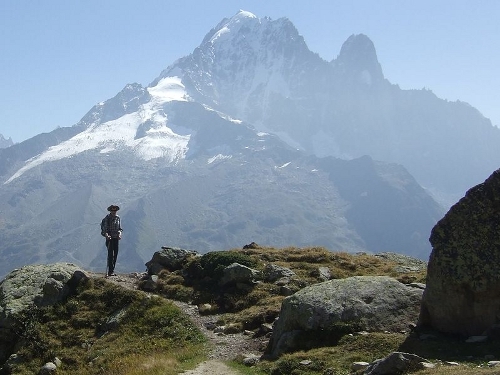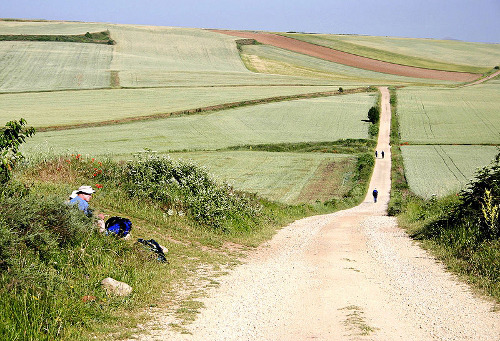 There are so many great walks in Europe, covering such a vast spectrum of geological, ecological and anthropogenic wonder, that attempting to cover them all in a single article is impossible. In fact, trying to do so in a whole book would be tough – though some have tried, with greater or lesser success.
There are so many great walks in Europe, covering such a vast spectrum of geological, ecological and anthropogenic wonder, that attempting to cover them all in a single article is impossible. In fact, trying to do so in a whole book would be tough – though some have tried, with greater or lesser success.
So instead, here I will outline the case for greatness of three of my favourite European walks. As for the greatest of all, I’ll leave that up to you. But if you are thinking about following in the many footsteps that have criss-crossed Europe’s byways and highways over the millennia, here are some splendid walks to consider attempting.
Camino de Santiago
St-Jean-Pied-de-Port, France to Santiago de Compostela, Spain
We start with one of the most famous walks of all. Synonymous with religious pilgrimages through the centuries, the Camino de Santiago – or Way of St James – is actually a series of routes with numerous starting points, all of which converge on the northern Spanish city of Santiago de Compostela. There resides the cathedral in which – legend has it – the remains of the apostle Saint James were laid to rest.
The most popular route – the Camino Frances, or French Way – begins on the French side of the Pyrenees at the aptly named Saint-Jean-Pied-de-Port, where other ‘feeder’ routes from across France and beyond meet. Approximately 780 km from there to the final destination, only those pilgrims with the time, energy and ambition (religious or otherwise) will attempt the whole of this part of the trek.
 Thankfully, there are many valid starting points, all of which still take in many of the highlights. Popular commencement points for those wanting a challenge without having to quit the day job include León, the capital of its eponymous province, which is some 300 km from Santiago, or Sarria – in Lugo province – which is the final leg of the Camino and, at ‘just’ 110 km or so, makes a fine moderate walking holiday over a few days or a week.
Thankfully, there are many valid starting points, all of which still take in many of the highlights. Popular commencement points for those wanting a challenge without having to quit the day job include León, the capital of its eponymous province, which is some 300 km from Santiago, or Sarria – in Lugo province – which is the final leg of the Camino and, at ‘just’ 110 km or so, makes a fine moderate walking holiday over a few days or a week.
Whether religious or not, you can get into the mood of the pilgrimage by obtaining a document called the credencial (or pilgrim’s passport), which gives access to inexpensive – occasionally free – accommodation along the trail. You can even collect stamps at various points along the route. Upon arrival at Santiago de Compostela, as long as you have either walked over 100 km or cycled 200 km, you will be given a compostela (certificate of accomplishment) when you present your credencial as proof.
This walk, which will take you through areas of particular botanical abundance, offers numerous chances to replenish energy levels on the hearty fare of the Spanish countryside: lots of meat (the milk-fed roast lamb is divine!), wild mushrooms and truffles, bread and plenty of Rioja to wash it down.
Coast to Coast
St Bees to Robin Hood’s Bay, England
The Coast to Coast walk was one of the many brainchildren of the late, great fell walker, guidebook author and illustrator, Alfred Wainwright. The route is 192 miles in length (though a re-measurement in recent times suggests it is more like 220 miles) from the west coast of England to the east.
 Crossing three of England’s finest National Parks – the Lake District, the Yorkshire Dales and the North York Moors – walkers are presented with scenery that drifts from the breathtaking, to the dreamy then to the altogether otherworldly. Setting off at dawn over the mist-enveloped moors is a sight to behold.
Crossing three of England’s finest National Parks – the Lake District, the Yorkshire Dales and the North York Moors – walkers are presented with scenery that drifts from the breathtaking, to the dreamy then to the altogether otherworldly. Setting off at dawn over the mist-enveloped moors is a sight to behold.
Based on Wainwright’s 1973 guidebook to the route – with comes complete with hand-drawn maps – the route fits well into a two-week holiday with a walking schedule that even includes a couple of rest days. Of course, you can take longer or push for a swifter trip as you see (and feel) fit.
But however long you take, you will appreciate the stark, dramatic and ever-present natural beauty of this walk. And there is no shortage of interesting and welcoming stop-off points along the way, not to mention the many truly great country pubs. Pint of bitter, anyone?
Tour du Mont Blanc
Les Houches, Chamonix, France
This 105 mile circular route through the French, Swiss and Italian Alps is not for the faint of heart or weak of limb. It is tough, as you might expect when walking around the Mont Blanc Massif, but the awe-inspiring views of Europe’s highest peak help spur you on.
 Swiss aristocrat Horace Bénédict de Saussure was the first (recorded) person to hike the route, way back in 1767 – when Swiss aristocrats apparently did things like that for kicks. It gained popularity with the adventurous Victorians, though they would often prefer the views from the backs of mules. Mules are less abundant as forms of transport these days, as hikers tend to opt for their own two feet. And those who take on this challenging trek will not be disappointed.
Swiss aristocrat Horace Bénédict de Saussure was the first (recorded) person to hike the route, way back in 1767 – when Swiss aristocrats apparently did things like that for kicks. It gained popularity with the adventurous Victorians, though they would often prefer the views from the backs of mules. Mules are less abundant as forms of transport these days, as hikers tend to opt for their own two feet. And those who take on this challenging trek will not be disappointed.
A word of caution: with the potentially dangerous terrain, fast-changing weather conditions and the all-too-common possibility of simply getting lost, unless you are a seasoned fell walker or climber, I would recommend going in a group with an experienced guide. That way you get the views without the fear… and a few extra buddies with whom to share a vin chaud or three of an evening.
Of course, there are many options available to do shorter sections of the Tour du Mont Blanc, many of which make perfect day-hikes. And you can even save your legs in some locations and get the cable car up (or back down). All-in-all, though, nothing quite beats the exhilaration of using your own steam to make it up to these cloud-high vantage points, from where you will discover some of the best views Europe has to offer.











